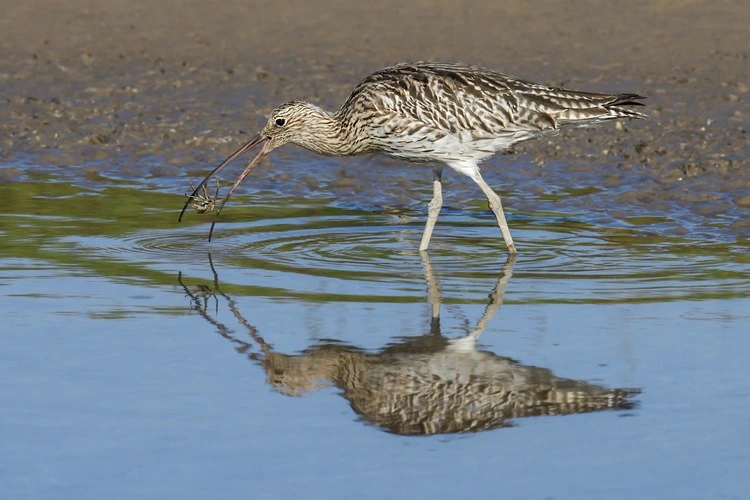
Rory Walsh explores the scenery and sights of the fascinating Dee Estuary between Wales and England
Walk • Coastal • Wales • Guide
It’s a strange feeling, standing in one country while looking at another. Perhaps, because unlike on large continents, Britain’s small island offers fewer opportunities. From the Flintshire coast in North Wales, you can see the Wirral in northwest England. Thanks to childhood atlases, with nations illustrated in assorted colours, part of me expects the two coastlines to be contrasting hues. Pink, purple or orange maybe. Instead, the scene is a wash of greys and browns, divided and dominated by the Dee Estuary.
The Dee Estuary is a literal borderline landscape. Its tidal waters are a physical barrier between Wales and England. The estuary is also a shifting, transitional place: neither land nor sea but somewhere in between. At various times it looks very different. The water can be a raging mass, pounding the shore, or barely visible at all, dribbling over swathes of mud. Some stretches feel like a riverbank, albeit dotted with seaweed and crab shells. Others recall a beach but with factories instead of an esplanade.
Enjoying this article? Why not check out some of our other top reads…
To explore how this marginal area developed, the walk begins at the dramatic ruins of Flint Castle. At the car park outside, local wags have turned the signpost upside down. It’s the first of many inversions. The former moat has become a grassy ditch where children run and play. Meanwhile, a roofless tower collects rainwater. Flint’s town motto is ‘Castellum supra fluvium’ or ‘Castle on a river’. The castle is now separated from the Dee by a carpet of saltmarsh. Centuries of tidal deposition have effectively moved it inland.
Flint Castle was completed in 1284. Though a Welsh landmark, it was built for an English king, Edward I. Edward ordered an ‘iron ring’ of castles to be built to subdue Welsh tribes. Flint’s location, on a rocky headland a day’s march from Chester, was an ideal defensive site. The Dee Estuary below was accessible by land and sea. Estuaries became strategic military positions. Therefore, many of Edward’s other Welsh castles – including Rhuddlan, Harlech, Conway, Caernarfon and Beaumaris – were built beside them.
From the castle, the walk follows the Wales Coast Path upriver to the Bettisfield Colliery site, near the village of Bagillt. Stretching out on my right, the Dee Estuary is a constant companion, its classic V-shape ever expanding towards Liverpool Bay. When I begin, the tide
is out. The Wirral is a distant line of woodland beyond an expanse of gloopy green-brown mud. The sky is pale grey and the air smells salty on a rustling breeze. Flocks of small seabirds sit in the ooze like lumps of coal.
At first glance, the scenery can seem rather bleak. Yet there is beauty and diversity. The estuary’s mix of sea and river water creates a soup of nutrients, which benefit diverse species. During the walk, I spot bees, butterflies and burnet moths supping on wildflowers. Sparrows take dust baths and swifts dart by at head height. The route even passes a natterjack toad reserve. Seals have been seen in the water. Teeming with tiny invertebrates, even the tidal mud is full of buried life.

Today, the Dee Estuary fuels paper mills and steel works, as well as two power stations. In previous centuries, it supported maritime trade. A reminder appears at Flint Dock. Partly flanked by a line of silver birches, it’s now a small muddy inlet. Yet from the 1800s, Flint Dock berthed up to 20 boats a day. Vessels were loaded with coal, timber and Halkyn Mountain lead. While the wharves teemed with activity, a neighbouring Victorian chemical works employed 2,000 people. But where the sea gives, it also takes.
By the 1890s, railways tipped Flint Dock towards decline. The downfall, however, was coastal change. Like all rivers, the Dee deposits sediment along its course. In estuaries, the sea sweeps sediment back inland. As a result, estuaries are very prone to silting up. The process accelerated in the Dee Estuary following a neighbour’s success. As Liverpool became a major port, the Mersey Estuary on the other side of the Wirral was dredged. The Mersey’s sediment was dumped in Liverpool Bay, where tides washed it into the Dee.
Leaving Flint Dock, the air fills with a crackling sound. Trickles of silty water enter the inlet, brown and foamy as beer. The tide is coming in. For the rest of the walk, we pass in opposite directions. The curve of Flint Point offers vast views as the estuary widens. The Flintshire and Wirral coastlines suggest a pair of long arms, vainly reaching out to hold back the deluge.
As the path climbs, there are rockfalls along the cliff edge. Some look like giant bite marks, where the hungry water has eaten into the land.

Estuaries are particularly vulnerable to erosion as water fills them from two directions at once. While walking along Panton Cop, I spot criss-cross patterns on the water’s surface where the river and sea meet. Panton Cop is a flood barrier that separates the Dee Estuary from farmland and a railway line. The path is just wide enough for single-file pedestrians, with steep drops on either side. While sheep and cattle graze on the left, the expanse of water on the right feels immense.
The Dee Estuary formed at the end of the Ice Ages, where glaciers retreating north from the Welsh mountains carved through soft sandstones and coal measures. The estuary’s widest point spans some eight kilometres. The tidal range is from 4.1 to 7.7 metres and the water level varies constantly.
At high tide, the estuary’s funnel shape can create a ‘bore’ wave. In January 2014, a tidal surge breached Panton Cop. Up on the narrow ridge, it’s easy to imagine how.
Past Panton Cop, the walk bears left around Bagillt Marsh to reach another small inlet. was a thriving quayside cut beside Bagillt railway station to transport coal, lead and copper along the estuary. Today the area is eerily quiet. Like Flint Dock, Station Gutter silted up. Trade declined and Bagillt Station closed in the 1960s during the infamous Beeching cuts. Trains still pass through, whistling by like giant bullets.
From the footbridge above the abandoned platforms, a strange sight emerges: a metal dragon clawing at the horizon.

A signpost marked ‘viewpoint’ directs me up a verdant hillside. The dragon stands on a pedestal at the summit. Rust red and the size of a motorbike, the Bagillt Beacon has gazed across the Dee Estuary since 2012. It’s carefully positioned to face the sunrise of the summer solstice. The sculpture also provides a physical and symbolic marker of Welsh land. Its hilltop home was originally a waste tip of Bettisfield Colliery. Until it closed in 1934, Bettisfield was the largest of 11 coal mines around Bagillt village.
While surrounding land has been transformed, the former mine buildings are in a sorry state. The walk ends at Bettisfield’s old winding house. Almost derelict, it adjoins a garage and breakers’ yard. As a listed building, the structure can’t be demolished.
Yet the site’s location makes it very difficult to restore and regenerate.
Like Flint Castle, it’s a ruin left in limbo, a marginal space in a marginal landscape. Yet sometimes the margins are the most interesting places, following a different current to the main stream.
Discover more about Britain…

Go to the Discovering Britain website to find more hikes, short walks, or viewing points. Every landscape has a story to tell!




